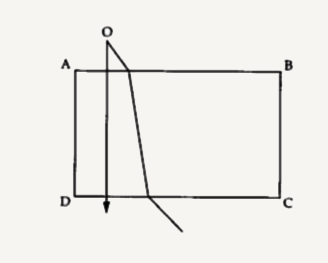A point source of light O of single colour is seen through a rectangular glass slab PQRS. The paths of two rays, in and outside the slab, are shown in figure.

In the diagram, label the position I of the source O where it will appear when seen through the surface RS.
(ii) Does the source O appear to be nearer or farther with respect to the surface PQ ?
(iii) How does the shift depend on the thickness PS or QR of the slab?
(iv) Justify your answer in (iii) with the help of an appropriate ray diagram.
(v) For the same rectangular glass slab, which colour from the visible spectra (violet to red) will produce the maximum shift ?
(i) In figure, I is the position of source O when seen through the surface RS.

(ii) The source O appears to be at I, nearer with respect to the surface PQ when viewed through the surface RS.
(iii) The shift OI decreases with the decrease in thickness PS or QR of the slab.
(iv) The ray diagram is shown in figure in which for the thickness PS, the image is at I, while for the thickness PS.( (v) The same rectangular glass slab will produce the maximum shift for violet light incident on it for which the refractive index of glass is most.
Topper's Solved these Questions
- REFRACTION OF LIGHT AT PLANE SURFACESBOOK - ICSECHAPTER - REFRACTION OF LIGHT AT PLANE SURFACESEXERCISE - EXERCISE-4(A)
31 Videos
- REFRACTION OF LIGHT AT PLANE SURFACESBOOK - ICSECHAPTER - REFRACTION OF LIGHT AT PLANE SURFACESEXERCISE - EXERCISE-4(A) MULTIPLE CHOICE TYPE
3 Videos
- REFRACTION OF LIGHTBOOK - ICSECHAPTER - REFRACTION OF LIGHTEXERCISE - DIAGRAM BASED MCQ:
5 Videos
- REFRACTION THROUGH A LENS BOOK - ICSECHAPTER - REFRACTION THROUGH A LENS EXERCISE - EXERCISE-5(D) (MULTIPLE CHOICE TYPE)
2 Videos
Similar Questions
A monochromatic point source of light O is seen through a rectangular glass block ABCD. Path of two rays in and outside the block are as shown in the figure below.
 .
.
(i) Does the source appear to be nearer or farther with respect to surface AB?
(ii) How does the shift depend upon the thickness AD or BC of the block ?
(iii) Justify your answer in (ii) with the help of ray diagram.
(iv) For the same rectangular block which colour from the visible spectra will produce the maximum shift ?
View SolutionA monochromatic point source of light O is seen through a rectangular glass block ABCD.
Paths of two rays, in and outside the block, are shown in the figure below.

How does the shift depend on the thickness (AD or BC) of the block?
View Solution
Knowledge Check
The path of a ray light coming from air passing through a rectangular glass slab traced by four students are shown as A, B, C and D in Figure. Which one of them is correct ?
 AABBCCDD
AABBCCDD
A monochromatic point source of light O is seen through a rectangular glass block ABCD.
Paths of two rays, in and outside the block, are shown in the figure below.

Does the source at point O appear to be nearer or farther with respect to the surface AB?
View SolutionA monochromatic point source of light O is seen through a rectangular glass block ABCD.
Paths of two rays, in and outside the block, are shown in the figure below.

Justify your answer with the help of an appropriate ray diagram as shown in figure.
View SolutionA monochromatic point source of light O is seen through a rectangular glass block ABCD.
Paths of two rays, in and outside the block, are shown in the figure below.

For the same rectangular glass block, which colour from the visible spectra will produce the maximum shift?
View SolutionWhy there is no dispersion of light refracted through a rectangular glass slab?
View SolutionWhy is there no dispersion of light refracted through a rectangular glass slab ?
View SolutionA ray of light falls normally on a rectangular glass slab.
Draw a ray diagram showing the path of the ray till it emerges out of the slab.
View SolutionThe path of a ray light coming from air passing through a rectangular glass slab traced by four students are shown as A, B, C and D in Figure. Which one of them is correct ?

View Solution
